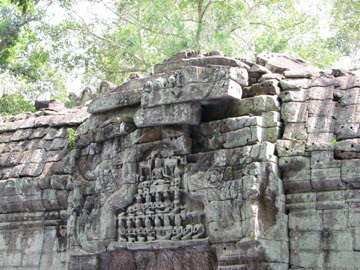We started our trip to Cambodia in Phnom Penh, where we visited the Royal Palace (below) and Silver Pagoda.
We also visited the Central Market (built in 1937) :
One of the most pyschologically difficult places we visited was the Toul Sleng Genocide Museum (aka S21) a former high school used as a prison and place of torture by the Khmer Rouge
Interrogators used the wooden pole (originally used for students' physical education) for torture. Prisoners were hung upside down until they lost consciousness, then their head was dipped into a barrel of filthy water which shocked the victim back into consciousness and the process started again.
Phnom Penh streetfood :
After a few day in Phnom Penh we travelled to the coast, to Sihanoukville to go diving. Our dive sites were two hours offshore near islands called the Koh Rong.
Leaving Sihanoukville we travelled to Siem Reap where we started visiting the fabulous temples of Angkor.
 |
| offering to Buddha - note the meat offering |
At the temples were many carving of apsaras - which are female devatas (angels).
At the most well-known temple, Angkor Wat, we saw bas-reliefs depicting the Ramayana, the Mahabratata and heaven and hell.
 |
| seated buddha in front of a naga |
Ta Phrom is famous as the temple that has been left overgrown with trees. Some might recognise it from the film Tomb Raider.
The Bayon Temple has fifty towers sculpted with four-faced Bodhisattva Avalokiteshvara. A bodhisattva is an enlightened being, and Avalokiteshvara is one who embodies the compassion of all Buddhas.
 |
| loved the colour contrast here |
 |
| four-faced Bodhisattva Avalokiteshvaras |
Typical Siem Reap tuk-tuk :
Statues depicting the Churning of the Sea of Milk - from Hindu mythology
These musicians have been maimed by landmines :
We later visited the Mine museum.
A typical Cambodian rural house on stilts :
Pre Rup temple at sundown :
South gate of Angkor Thom
On our last day in Siem Reap we went to Tonle Sap lake to see the floating villages.
After leaving Cambodia we travelled to southern Laos for a few days.
Suggested reading:
Angkor (New Horizons)
'Twixt Land and Sea (Penguin Great Books of the 20th Century) by Joseph Conrad. Not directly connected to Cambodia but more related to the Gulf of Siam this a collection of three short stories first published in 1912.
by Joseph Conrad. Not directly connected to Cambodia but more related to the Gulf of Siam this a collection of three short stories first published in 1912.



































No comments:
Post a Comment